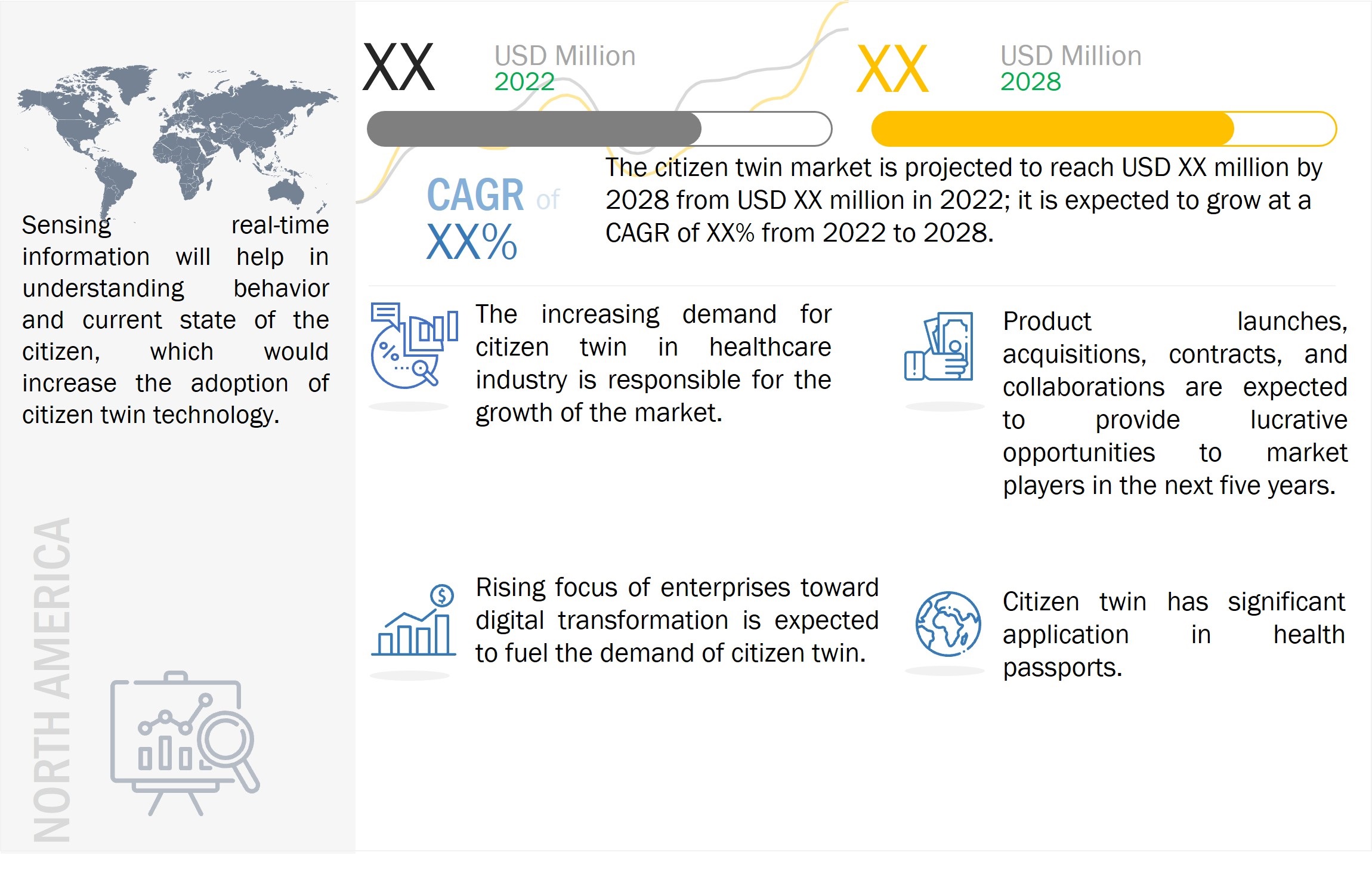Citizen Twin Market by Enterprise, Application (Product Design & Development, Performance Monitoring, Predictive Maintenance, Business Optimization), Industry (Aerospace, Automotive & Transportation, Healthcare, Energy & Utility) - Global Forecast to 2030
A citizen twin is the digital twin of the person or the creation of a virtual replica of a person—this would represent humans in both the real and virtual worlds. Citizen twin is developed with real-time context on organized digital services. The technology helps predict any unusual events for citizens and validates different what-if scenarios, offering the citizen the best engagement choice.
The global citizen twin market size is expected to grow from USD XX million in 2024 to USD XX million by 2030, at a CAGR of XX%. The key factors boosting market growth are the rising adoption of citizen twin for predicting diseases in the healthcare industry.

To know about the assumptions considered for the study, Request for Free Sample Report
Drivers: Citizen twin is expected to be highly adopted in the healthcare industry
With the rapid spread of the novel coronavirus, the healthcare and pharmaceutical industries are at the forefront of combating the pandemic. The pandemic has created real-world use cases for digital representations of a human’s physical being. Implementing citizen twins helps create a digital version of biometric measurements, such as glucose levels and heart rate. Additionally, citizen twins are also used to monitor health, enhance the surgical outcome, alert the system and recognize the pathology before the disorders are evident. Moreover, the digital human blueprint can also help predict future health issues and can be used to suggest a treatment. Hence, the rising use of citizen twins in the healthcare industry is expected to drive the market's growth.
Challenges: Lack of skilled workforce
The creation of a citizen twin a person requires various technologies and skillsets, along with trained workers to handle the latest software systems. The digital change will lead to a change in the specifications of skills required for employees at different stages of the value chain. The expected increase in working efficiency and data-dependency of processes would lead to the requirement of new employee skill sets and high qualifications. This could create a skill gap between the new workers and trained workers. Thus, the unavailability of a skilled workforce would hamper the market's growth.
To speak to our analyst for a discussion on the above findings, click Speak to Analyst

TABLE OF CONTENTS
1 Introduction
1.1. Study Objectives
1.2. Market Definition & Scope
1.2.1. Inclusion & Exclusion
1.3. Study Scope
1.3.1. Markets Covered
1.3.2. Years Covered
1.4. Currency
1.5. Limitations
1.6. Stakeholders
1.7. Summary of Changes
2 Research Methodology
2.1. Research Data
2.1.1. Secondary & Primary Research
2.1.2. Secondary Data
2.1.3. Primary Data
2.1.3.1. Primary interviews with experts
2.1.3.2. Key data from primary sources
2.1.3.3. Key industry insights
2.1.3.4. Breakdown of primaries
2.2. Market Size Estimation
2.2.1. Bottom-up Approach
2.2.2. Top-down Approach
2.3. Market Breakdown & Data Triangulation
2.4. Research Assumptions
3 Executive Summary
4 Premium Insights
5 Market Overview
5.1. Introduction
5.2. Market Dynamics
5.2.1. Drivers
5.2.2. Restraints
5.2.3. Opportunities
5.2.4. Challenges
5.3. Value Chain Analysis
5.4. Ecosystem
5.5. Pricing Analysis
5.5.1. Average Selling Price of Key Players
5.6. Trends/Disruptions impacting customer’s business
5.7. Technology Analysis
5.8. Porter Five Force Analysis
5.9. Key Stakeholders & Buying Criteria
5.10. Case Study Analysis
5.11. Trade Analysis
5.12. Patent Analysis
5.13. Key Conferences & Events in 2022-2023
5.14. Tariff and Regulatory Landscape
5.14.1. Regulatory Bodies, Government Agencies, And Other Organizations
5.14.2. Regulations and Standards
6 Citizen Twin Market, by Enterprise
6.1. Introduction
6.2. Large Enterprises
6.3. Small & Medium Enterprises (SMEs)
7 Citizen Twin Market, by Application
7.1. Introduction
7.2. Product Design & Development
7.3. Performance Monitoring
7.4. Predictive Maintenance
7.5. Inventory Management
7.6. Business Optimization
7.7. Other Applications
8 Citizen Twin Market, by Industry
8.1. Introduction
8.2. Aerospace
8.3. Automotive & Transportation
8.4. Infrastructure
8.5. Healthcare
8.6. Energy & Utility
8.7. Oil & Gas
8.8. Agriculture
8.9. Telecommunications
8.10. Retail
8.11. Other Industries
9 Geographic Analysis
9.1. Introduction
9.2. North America
9.2.1. US
9.2.2. Canada
9.2.3. Mexico
9.3. Europe
9.3.1. UK
9.3.2. Germany
9.3.3. France
9.3.4. Rest of Europe
9.4. Asia Pacific
9.4.1. China
9.4.2. Japan
9.4.3. India
9.4.4. Rest of Asia Pacific
9.5. Rest of the World
9.5.1. Middle East & Africa
9.5.2. South America
10 Competitive Landscape
10.1. Introduction
10.1.1. Revenue Analysis of Top 5 Companies
10.2. Market Share Analysis of Top 5 Players, 2021
10.3. Company Evaluation Quadrant, 2021
10.3.1. Stars
10.3.2. Emerging Leaders
10.3.3. Pervasive
10.3.4. Participants
10.4. Small and medium Enterprises (SME) Evaluation Quadrant, 2021
10.4.1. Progressive Companies
10.4.2. Responsive Companies
10.4.3. Dynamic Companies
10.4.4. Starting Blocks
10.5. Citizen Twin Market: Company Footprint
10.6. Competitive Benchmarking
10.7. Competitive Situation and Trends
10.7.1. Product Launches and Developments
10.7.2. Deals
11 Company Profiles
(Business Overview, Products Offered, MnM Viewpoint)
11.1. Key Players
1.1.1. General Electric
1.1.2. Microsoft
1.1.3. Siemens
1.1.4. Amazon Web Services
1.1.5. Dassault Systemes
1.1.6. Ansys
1.1.7. IBM
1.1.8. PTC
1.1.9. SAP
1.1.10. Oracle
1.1.11. Robert Bosch
12 Adjacent Market
13 Appendix















Growth opportunities and latent adjacency in Citizen Twin Market